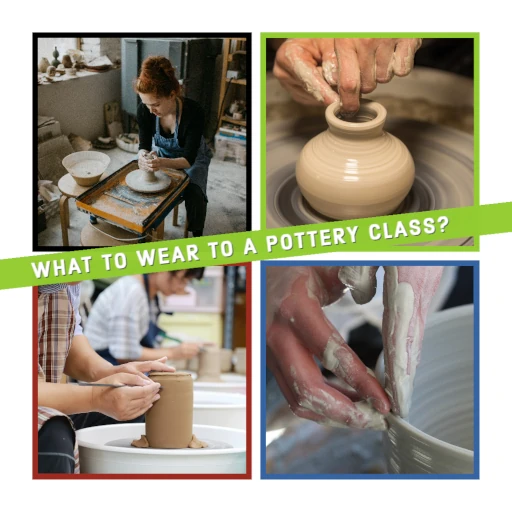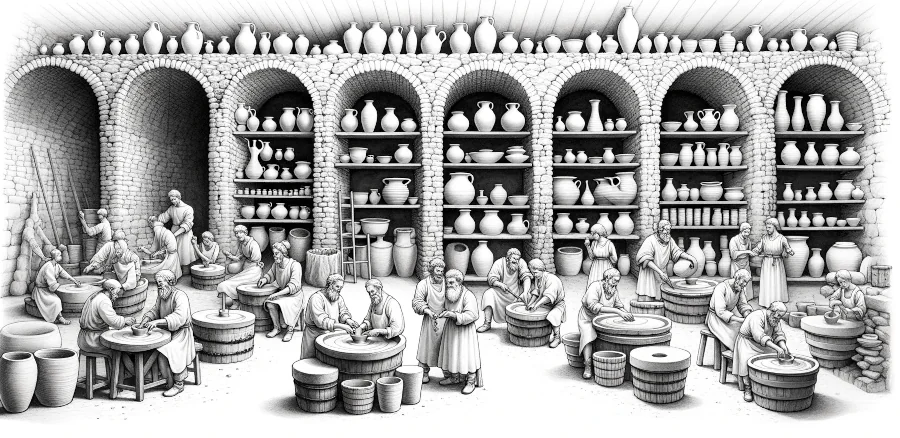When heading out, comfort is key. Opt for old, loose-fitting clothing you don’t mind getting messy, as clay splatters are inevitable. Closed-toed shoes are a must for safety, and short sleeves or rolled-up sleeves are practical. Avoid dangly jewelry, as it can get caught. Lastly, tie back long hair to keep it out of the way and clay-free. Happy potting!
Pottery Class Attire: Quick Reference
| Item | Recommended? | Benefits | Notes |
|---|---|---|---|
| T-shirt | Yes | Easy to move in, can get dirty | Opt for old shirts, preferably cotton |
| Jeans/Loose Pants | Yes | Protects legs from splatters | Avoid tight or restricting pants |
| Apron | Highly Recommended | Shields clothes, pockets for tools | Cotton aprons are ideal, avoid overly thick materials |
| Closed-toe Shoes | Yes | Protects feet, non-slip | Avoid sandals or open shoes |
| Tight-fitting Jewelry | No | Can get caught or stained | Remove rings, long necklaces, or dangly earrings |
| Short Nails | Preferred | Easier to work with clay, avoids imprints | Long nails can interfere with molding the clay |
| Hair Tie | For Long Hair | Keeps hair out of clay and face | Avoid any distractions or obstructions |

Dressing for a pottery class, now that’s an art in itself! Over the years, I’ve seen both seasoned potters and first-timers and there’s a clear difference in their attire. Let me break it down for you, here are my 8 secrets:
- Clothing. You’ll want to wear clothes that you don’t mind getting dirty. Clay, especially when wet, can splatter and stain. Loose, old clothing that allows you to move freely is ideal. Remember, you’ll be sitting at a wheel, bending, and stretching, so comfort is paramount.
- Why It’s Important: You’ll want to wear clothes that you don’t mind getting dirty. Clay, especially when wet, can splatter and stain. The type of clay you’re working with can also have varying effects on your clothing. For example, darker clays can leave permanent stains. Loose, old clothing that allows you to move freely is ideal. Remember, you’ll be sitting at a wheel, bending, and stretching, so comfort is paramount. The right clothing ensures you can focus on your art without worrying about ruining your outfit.
- Shoes. Closed-toed shoes are a must. They offer protection against any dropped tools or clay. Plus, when you’re at the wheel, you’ll use your foot to control the pedal, so you’ll want a shoe that gives you good control. Avoid sandals or anything with open toes unless you like having clay feet, ha!
- Why It’s Important: Closed-toed shoes are a must. They offer protection against any dropped tools or clay. Plus, when you’re at the wheel, you’ll use your foot to control the pedal, so you’ll want a shoe that gives you good control. The closed design prevents any clay or tools from injuring your toes, providing both safety and functionality.
- Sleeves. If you’re working on the wheel, shorter sleeves or sleeves that can be easily rolled up are preferred. Long sleeves can get caught in the clay or drag across your work.
- Why It’s Important: If you’re working on the wheel, shorter sleeves or sleeves that can be easily rolled up are preferred. Long sleeves can get caught in the clay or drag across your work, potentially ruining your project and causing frustration.
- Jewelry. Best to leave your precious jewelry at home. Rings can get caught in the clay, and necklaces might dangle into your work. Plus, the clay can be abrasive and might scratch softer metals.
- Why It’s Important: Best to leave your precious jewelry at home. Rings can get caught in the clay, and necklaces might dangle into your work. Plus, the clay can be abrasive and might scratch softer metals. Wearing jewelry not only risks damaging the jewelry but can also interfere with your creative process.
- Hair. If you have long hair, tie it back or put it up. Trust me, you don’t want to lean over and find your hair imprinted in your almost-finished masterpiece!
- Why It’s Important: If you have long hair, tie it back or put it up. Trust me, you don’t want to lean over and find your hair imprinted in your almost-finished masterpiece! Long hair can become a nuisance and even a hygiene issue if it gets caught in the clay.
- Apron. Some potters swear by aprons, and they can be quite handy. They protect your clothes and often have pockets to hold tools. However, if you don’t have one, don’t fret. Many studios provide communal aprons, or you might find you’re okay without.
- Why It’s Important: Some potters swear by aprons, and they can be quite handy. They protect your clothes and often have pockets to hold tools. However, if you don’t have one, don’t fret. Many studios provide communal aprons, or you might find you’re okay without. An apron serves as a multi-functional tool, offering both protection and convenience.
- Glasses. If you wear them, just ensure they fit securely. They can get foggy or splattered, so maybe bring a little cleaning cloth.
- Why It’s Important: If you wear them, just ensure they fit securely. They can get foggy or splattered, so maybe bring a little cleaning cloth. Secure-fitting glasses ensure that your vision remains clear, allowing you to focus on the intricate details of your work.
- Nails. If you have long nails, you might find them a hindrance when shaping and molding the clay. Some potters keep their nails short for this reason.
- Why It’s Important: If you have long nails, you might find them a hindrance when shaping and molding the clay. Some potters keep their nails short for this reason. Long nails can interfere with the tactile experience of molding clay and may even leave unintended marks on your work.
While it’s about what you wear, don’t forget to bring along a towel. It’s handy for wiping your hands, mopping up spills, or even sitting on if the studio stools are hard or cold.
So, there you have it my 8 secrets for dressing for pottery. It isn’t about fashion, it’s about function. Once you’re dressed right, you can focus all your attention on the clay and your creativity!
Pottery Class Practical Tips for Specific Needs
Long Nails
Why It’s Important: If you have long nails, you might find them a hindrance when shaping and molding the clay. However, that doesn’t mean you have to cut them off to enjoy pottery.
Tips:
- Use the tips of your fingers rather than the flat part to shape the clay.
- Consider using a sponge on the inside and your knuckle on the outside to pull up the clay.
- If you can’t let go of your long nails, try using only your knuckles when pulling up the clay.
Sensitive Skin
Why It’s Important: Clay can be drying to the skin, and if you have sensitive skin, this could be a concern.
Tips:
- Use a hypoallergenic moisturizer before and after your pottery session.
- Wear thin cotton gloves to minimize direct contact with the clay.
Vision Impairment
Why It’s Important: If you wear glasses or contact lenses, you’ll need to take special precautions to ensure they don’t become a hindrance.
Tips:
- Make sure your glasses fit securely to prevent them from slipping off.
- If you wear contact lenses, consider bringing a small mirror and lens solution in case you need to adjust or clean them.
Mobility Issues
Why It’s Important: Pottery involves a lot of hand-eye coordination and fine motor skills. If you have mobility issues, you might find some tasks challenging.
Tips:
- Use ergonomic tools designed for easier grip and control.
- Consider using a pottery wheel that can be adjusted for height and angle to accommodate your needs.
What Not to Wear to a Pottery Class

So, back in the ’90s, I observed this young man, Alex, in a beginner class. Alex was a flamboyant fellow, always dressed to the nines. You will have to use your imagination. One evening, he strutted into the studio wearing pristine white pants, thinking he was about to attend a laid-back painting class, I guess. He must have confused pottery with another art workshop he’d signed up for.
Well, I took one look and thought, “This will be interesting!” I did offer him a spare apron, but he declined with confidence, believing he could manage without making a mess.
Not ten minutes in, as he started centering the clay on the wheel, it splashed all over. His pristine white pants had turned into a canvas of abstract clay art! And his designer shoes? Well, let’s just say they looked like they’d been through a muddy festival.
While the situation was comical, what I truly admired was Alex’s spirit. Instead of storming out embarrassed, he laughed along with the rest of us, making jokes about his new “designer” attire. He said, “Well, I guess I’ve got a one-of-a-kind pants and shoes now!” He continued the class and returned for the next, this time in old jeans and a t-shirt.
Does Pottery Clay Stain Clothes?
Oh, the number of times I’ve been asked this in my years of pottery! Pottery clay, my dear friend, can indeed leave its mark, both on the potter and their attire. Let’s delve a bit deeper into this age-old conundrum.
The primary component of most pottery clays is finely ground minerals, predominantly kaolin in many types. When this meets water (as it often does during the pottery process), you get that nice, sludgy consistency that can find its way onto clothes, shoes, hair and you name it!
Now, onto the staining part. Wet clay, especially if it’s darker or has added pigments, can leave smudges or marks on fabric. The good news? Most clay, when it’s still fresh, is relatively easy to wash out, especially from durable fabrics like cotton. However, if the clay is left to dry on the clothing, it can be a bit more stubborn. The dry clay itself brushes off easily, but sometimes, especially with finer or more porous fabrics, a faint residue might linger.
As for glazes or underglazes, watch out as those are a whole different story! They contain colorants and, once set (especially if accidentally fired or baked in the sun), can leave permanent marks.
Advice from an old hand:
- Wear clothes you won’t lament getting dirty. Think of them as your “pottery uniform”!
- If you do get clay on your clothes, try to rinse it out while it’s still wet. It’s much easier to deal with then.
- For those extra stubborn clay marks on clothes, soaking the garment in water can help. A gentle scrub with a brush can work wonders too.
- And remember, pottery is a beautifully messy art. Embrace the splatters and smudges as badges of honor in your creative journey!
Can You Wash Off Clay Splatters?

Ah yes, clay splatters. The bane of every potter’s existence, yet a mark of a day well spent in the studio! Over the years, I’ve had my fair share of them, and trust me, they can be both a pain and a humorous reminder of your artistic endeavors. Let me share my wisdom on tackling those pesky clay remnants.
Fresh Clay Splatters
Fresh, wet clay splatters are your best friend because they’re the easiest to deal with. If you’ve gotten a fresh dollop on your clothes, shoes, or even your skin, a quick rinse with water will usually do the trick. You’ll want to get to it sooner rather than later to prevent it from drying.
Dried Clay Splatters
Now, dried clay is a bit trickier. If it’s on a hard surface like a tabletop or a tool, a simple scrape or brush-off usually gets most of it off. For clothes, here’s my tried and true method:
- First, brush off as much of the dried clay as you can.
- Then, soak the garment in cold water for a bit. The clay will start to soften.
- Gently scrub the spot with a soft brush or even your fingers. Most of the time, this will get the clay out.
- If there’s still a faint stain, consider using a gentle detergent or stain remover before tossing it in the wash.
Clay Splatter Considerations
- Different clay bodies have different staining capacities. Porcelain, for instance, is less likely to stain than a heavily grogged or iron-rich stoneware.
- Sometimes, especially if the clay has been mixed with pigments or if you’re using a heavily colored clay, there might be a slight tint left even after washing. In such cases, a fabric stain remover can be helpful.
Finally, a little tidbit from my years of experience: Embrace the splatters, especially if you’re just starting out or trying new techniques. They’re a testament to your hard work and commitment to the craft. And over the years, you’ll find that with each splatter, you’ll have a story or a memory associated with it.
Do You Get Dirty Making Pottery?
I can tell you, pottery is a beautiful, expressive, and yes, often messy art form. Even the most skilled potters will find themselves splattered with clay, especially when working on the wheel. Here’s a rundown:
1. The Wheel. When you’re throwing on the wheel, water and clay mix, creating slip, which can easily splash onto your clothes, hands, and face. If you’re working with a particularly soft or watery mix, or if you’re centering a larger lump of clay, expect to get more splatter. It’s part of the charm!
2. Hand Building. While hand building might not produce the same kind of splashy mess as wheel throwing, it still has its moments. Slipping and scoring to join pieces can get your hands and workspace quite messy. And, if you’re like me, you might find clay in unexpected places, like behind your ear or on your elbow.
3. Glazing. This is another step where things can get a tad chaotic, especially if you’re dipping or pouring glazes. Even brushing on glazes can lead to drips and drops on your workspace and yourself.
4. General Studio Work. Beyond the actual making of pottery, the studio itself can be a source of dirt and dust, especially when you’re reclaiming clay, mixing glazes, or even just moving things around.
However, while you’ll certainly get your hands dirty, there’s a therapeutic quality to it. Feeling the clay between your fingers, shaping it, and even the process of cleaning up afterward can be incredibly grounding. Many of us find the tactile nature of clay to be one of the most appealing aspects of pottery.
So, yes, making pottery can be a messy affair, but it’s all part of the joy. It’s a sign of a day well-spent in the studio. And trust me, the results of holding a finished piece you’ve crafted makes all the mess more than worth it. Just remember to wear clothes you don’t mind getting dirty, and embrace the process!
What is the Best Type of T-shirt to Wear for a Pottery Class Outfit?

When it comes to choosing the best T-shirt for a pottery class, comfort and practicality are key.
1. Material
Cotton or a cotton blend is your best bet. It’s breathable, comfortable, and easy to clean. Plus, cotton can absorb some of the water and slip without becoming too heavy or uncomfortable. If you’re in a hotter climate or a studio without great ventilation, you might also consider moisture-wicking materials to keep you cool.
2. Fit
Opt for a looser fit. A T-shirt that’s too tight might restrict your movements, especially when you’re reaching across the wheel or sculpting. However, avoid overly baggy shirts; sleeves or excess fabric can accidentally dip into clay or get caught.
3. Color
Darker colors or earth tones are ideal. They tend to hide clay splatters better than light colors. While clay generally washes out, some stains, especially from colored or iron-rich clays, can be stubborn.
4. Neckline
A standard round neck is usually the most practical. Avoid deep V-necks or wide boat necks; you don’t want clay getting inside your shirt.
5. Durability
Consider having a set of T-shirts dedicated just for pottery. These shirts will likely see a lot of wear and tear, so they don’t need to be your most stylish ones. But they should be durable.
6. Sentimental Value
Don’t wear a shirt with high sentimental value to the pottery studio. Even though most clay washes out, there’s always a chance of permanent staining, especially once glazes come into play.
I say the best T-shirt for pottery is one that allows you to move freely, keeps you comfortable, and one you won’t mind getting a little messy. After all, pottery is all about getting hands-on and enjoying the process, so dress in a way that lets you fully engage without any worries.
Are Cotton Aprons Suitable for Wearing in a Pottery Class?
Cotton aprons in my opinion are a classic choice for many artists and craftsmen, including potters like me. For an in-depth analysis of pottery aprons, types and material and care instruction read my article called “The Best Apron for Potters: The Perfect Apron”.
Cotton Aprons Pros in a Pottery Studio
- Absorbency. One of the primary benefits of a cotton apron is its absorbency. When you’re working at the wheel or hand-building, you’ll inevitably have wet hands, and it’s handy to have an apron that can quickly absorb the moisture or slip when you wipe your hands on it.
- Breathability. Pottery can be surprisingly physical, especially when throwing on the wheel. Cotton is breathable, preventing you from overheating too much.
- Washability. After a few sessions, your apron is bound to get dirty. Cotton aprons can typically be tossed in the washing machine, making them easy to clean. Just be sure to remove any large chunks of clay before washing.
- Durability. Good-quality cotton aprons can be quite durable, standing up to many sessions at the pottery wheel. Over time, they might even bear the lovely patina of clay splashes, a testament to your work and dedication.
- Customization. Many potters, myself included, enjoy personalizing their aprons, whether by dyeing, embroidering, or even stamping patterns using different clay slips. Cotton is a versatile fabric that lends itself well to these creative pursuits.
However, a couple of things to note, Cotton Apron Cons:
- Weight. When a cotton apron gets wet, it can become quite heavy. So, if you’re someone who uses a lot of water or slip when working, this might become cumbersome over time.
- Drying. It’s essential to let the apron dry thoroughly between uses. Hanging it up in an airy space is ideal. If left folded or bunched up while wet, it can develop a musty smell.
In my experience, while cotton aprons are suitable for pottery and favored by many, some potters prefer aprons made of lighter materials or those that have pockets, split-leg designs, or other features. Ultimately, the best apron is the one that feels most comfortable and meets your personal needs in the studio. But yes, a cotton apron is a tried and true choice for many a potter.
How to Make the Most Out of Your Pottery Class

Attending a pottery class is such a wonderful and enriching experience! Over the years, I’ve observed many beginners navigating their initial forays into the pottery world, and there are some pointers that can really make a difference. Here’s what I’d suggest:
- Come with an Open Mind. Pottery is as much about the process as it is about the end product. Don’t get too hung up on making the “perfect” piece right away. Embrace mistakes – they’re part of the learning journey.
- Dress Appropriately. As we’ve discussed, wear comfortable, older clothing. Clay can get everywhere, especially when you’re just starting. And, of course, a good apron can be your best friend!
- Listen Actively. When your instructor demonstrates a technique, watch closely and ask questions if something isn’t clear. Taking brief notes can also be a handy reference for later.
- Hands-On Practice. While watching and listening are essential, there’s no substitute for getting your hands dirty. The more you handle the clay, the better you’ll understand its properties and potential.
- Stay Patient. Centering clay on the wheel, for instance, is notoriously tricky for beginners. If you feel frustrated, take a deep breath, and remember: every potter has been where you are now.
- Ask for Feedback. Don’t hesitate to ask your instructor or more experienced classmates for tips or critiques. They might offer a new perspective or technique you hadn’t considered.
- Learn About the Kiln. Firing is a crucial part of pottery. Understand the different firing stages – bisque and glaze firings. Ask about the temperatures and types of kilns. The more you know about the firing process, the better your end results will be.
- Experiment with Glazes. Glazing can dramatically change the appearance of a piece. Test different glazes on small clay samples to see how they come out after firing. This will give you a better sense of how to glaze your main pieces.
- Clean Up Thoroughly. Respect shared spaces. Always clean your tools and workstation. Clay residue can harden and become difficult to remove if left unchecked.
- Connect with Classmates. Pottery is a wonderful community activity. Share experiences, learn from one another, and even collaborate on projects. You might make lifelong friends!
- Practice at Home. If you’re really keen, consider buying some clay to practice at home. Even without a wheel, you can practice hand-building techniques and refine your skills.
- Stay Inspired. Visit pottery studios, exhibitions, or watch videos online. The more you expose yourself to different styles and techniques, the more ideas you’ll have for your own creations.
- Save Artabys. Save this website in your favorites and visit frequently to lean more about being a ceramic artist! It’s always a good idea to keep resources close by, and this website should be no exception. Regularly visiting the site can provide you with valuable insights, tutorials, and a wonderful community of like-minded artists. It’s an essential tool for anyone passionate about diving deeper into the world of ceramics. Make sure to save it to your favorites and visit often. Share some tips for choosing the right pottery class for you, including considering the instructor’s experience and the type of pottery that is being taught. Thank you for your support.
Tips for Choosing the Right Pottery Class
My top tips for choosing the right pottery class. It can make a world of difference in your learning journey. Here are my top key pointers to consider:
- Define Your Objective. Before enrolling, ask yourself what you hope to achieve. Are you looking for a basic introduction, or do you wish to master a specific technique? Having clarity will guide your choice.
- Instructor’s Experience. Research the instructor’s background. With my 40+ years in the field, I can’t stress enough the importance of learning from someone who not only knows their craft but can teach it effectively. Check for any formal qualifications, the number of years they’ve been teaching, and if possible, their own pottery creations.
- Teaching Style. Everyone learns differently. Some might prefer hands-on, while others might thrive with demonstrations. If possible, observe a class or ask for a trial session. This helps you understand the teaching methodology.
- Type of Pottery Taught. Different classes might focus on different techniques, from wheel-throwing to hand-building, or specific types of pottery like sculpture, tiles, or functional ware. Choose one that aligns with your interest.
- Class Size. Smaller class sizes often mean more personalized attention. If you’re looking for a more intimate setting where you can get ample one-on-one time, look for classes with fewer participants.
- Facilities and Equipment. Check if the studio is well-equipped. Does it have multiple wheels, a variety of tools, and a good kiln? Adequate resources can greatly enhance your learning experience.
- Student Reviews. Look for testimonials or reviews from previous students. They can offer genuine insights into the learning experience and the quality of instruction.
- Duration and Schedule. Ensure that the class timings align with your availability. Some courses might be intensive short-term workshops, while others might span several weeks.
- Cost. While it’s tempting to opt for cheaper classes, it’s essential to ensure you’re getting value for your money. Sometimes, it’s worth paying a bit more for a class with a highly experienced instructor and better facilities.
- Location. Choose a location that’s convenient for you. If you’re truly passionate, a longer commute might be worth it, but for many, proximity can encourage consistent attendance.
- Safety Protocols. Especially if you’re taking classes in current times, ensure the studio adheres to safety and hygiene protocols.
- Community and Networking. Often, the best classes are not just about learning the craft but also about building a network of fellow pottery enthusiasts. This can be incredibly beneficial for motivation, collaboration, and continued learning.
Pottery Class Safety Measures
Dust Masks
Why It’s Important: Working with clay, especially when it’s dry, can produce fine particles that are harmful when inhaled. This is particularly true if you’re involved in activities like mixing dry clay or sanding bisqueware.
Tips:
- Consider wearing a dust mask when handling dry materials or when sanding your pottery pieces.
- Make sure to choose a mask that fits well and is designed to filter out fine particles.
Eye Protection
Why It’s Important: Splattering clay or glaze can pose a risk to your eyes.
Tips:
- Wear safety goggles when engaging in activities that could result in splattering, such as mixing glazes or using certain tools.
- Make sure your goggles fit well and are comfortable to wear for extended periods.
Proper Ventilation
Why It’s Important: Some pottery activities, like glazing and firing, can produce fumes that are harmful if inhaled.
Tips:
- Make sure to work in a well-ventilated area, especially when dealing with glazes or other chemicals.
- If you’re working in a home studio, consider installing an exhaust fan to help circulate air.
Chemical Safety
Why It’s Important: Glazes often contain chemicals that can be harmful if ingested or come into contact with your skin.
Tips:
- Always read the safety information for any glazes or chemicals you’re using.
- Consider wearing gloves when handling glazes, and always wash your hands thoroughly after your pottery session.
Interactive Quiz: Are You Ready for Your First Pottery Class?
Download Artaby’s Pottery Class Checklist PDF
Expert Interview: Insights from Meesh Switch
We had the opportunity to sit down with Meesh Switch, a renowned pottery expert and instructor, to get some insider tips and recommendations for those looking to start their pottery journey. Here’s what Meesh had to say:
Q: What’s the most important thing to consider when choosing what to wear to a pottery class?
Meesh Switch: “Comfort is key. You’re going to be moving around a lot, so you want to wear something that allows you the freedom to do so. Also, be prepared to get a little messy!”
Q: Any tips for beginners who might be nervous about their first class?
Meesh Switch: “Don’t be afraid to make mistakes. Pottery is all about learning and growing, and you can’t do that without a few bumps along the way.”
Q: What are some common misconceptions people have about pottery?
Meesh Switch: “Many people think pottery is just about making pots or vases, but it’s so much more than that. It’s a form of expression, a way to relax, and even a therapeutic activity for some.”
Q: What safety measures should one take when working with clay and pottery tools?
Meesh Switch: “Always be aware of your surroundings. Keep your tools organized and your workspace clean. If you’re working with materials that produce dust or fumes, make sure you’re in a well-ventilated area and consider wearing a mask.”
Q: Any last words of advice for our readers?
Meesh Switch: “Just dive in and have fun with it. Pottery is an incredibly rewarding experience, and you’ll get out of it what you put into it.“
Frequently Asked Questions (FAQ)

Q1: Can I start pottery at home without attending a class? Absolutely! While classes provide structured learning and hands-on guidance, many potters begin their journey at home. Start with basic hand-building techniques using air-dry clay. As you gain confidence, you can invest in more professional tools and materials. However, for techniques like wheel throwing and firing, a studio setup or classes can be beneficial.
Q2: Is pottery an expensive hobby to pick up? Pottery can have varying costs based on how you approach it. Starting with basic tools and air-dry clay can be quite affordable. As you delve deeper, expenses might include a pottery wheel, kiln, high-quality clay, and glazes. Many community centers offer shared studio spaces, which can be a cost-effective way to access pricier equipment.
Q3: How long does it take for a pottery piece to dry before it can be fired? Drying times can vary based on the size and thickness of your piece, as well as the humidity in your environment. Typically, smaller pieces can take a few days, while larger items might require a week or more. It’s crucial to ensure the piece is bone dry before firing to avoid cracks or explosions in the kiln.
Q4: Are there any health precautions I should consider when working with clay? Pottery is generally safe, but it’s essential to be mindful. Some precautions include wearing a mask when working with powders to avoid inhalation, cleaning hands thoroughly after handling clay (especially if it contains grog or other coarse materials), and ensuring your workspace is well-ventilated if using chemicals or glazes.
About the Author: Ed Shears
Hello, I’m Ed Shears, the creative force behind Artabys.com, a platform dedicated to promoting visual arts education and awareness. With a robust foundation in traditional pottery techniques, my true passion lies in creating unique ceramic wall art. Each piece I create is handbuilt with meticulous attention to detail, embodying originality and craftsmanship.
Credentials and Experience
- Education: A dedicated student of ceramic arts, my skills have been honed through rigorous training and hands-on experience.
- Artistic Philosophy: I believe in the unparalleled beauty of handcrafted original artwork, which not only adds a unique touch to living spaces but also resonates with the soulful touch of its creator.
- Achievements: I am a renowned author and contributor at Academia.edu and have showcased my artwork at Fine Art America since 2015.
For more about me and my work, feel free to visit my full artist page.
References
How to make pottery White, Mary. How to make pottery. Doubleday, Page, 1904.
The Potter’s Bible: An Essential Illustrated Reference for Both Beginner and Advanced Potters Scott, Marylin. The Potter’s Bible: An Essential Illustrated Reference for Both Beginner and Advanced Potters. Quarto Publishing Group USA, 2006.





